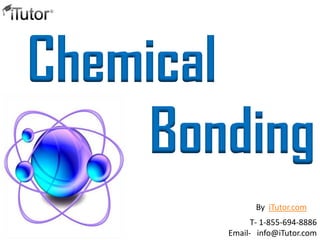Chemical Bonding
•Download as PPTX, PDF•
65 likes•89,590 views
Report
Share
Report
Share

More Related Content
What's hot (20)
Viewers also liked
Viewers also liked (9)
Similar to Chemical Bonding
Similar to Chemical Bonding (20)
Conditions for Formation of Ionic and Covalent Bonds

Conditions for Formation of Ionic and Covalent Bonds
Explain covalent bond- Explain Metallic bond and what important proper.docx

Explain covalent bond- Explain Metallic bond and what important proper.docx
More from itutor
More from itutor (20)
Recently uploaded
Mehran University Newsletter is a Quarterly Publication from Public Relations OfficeMehran University Newsletter Vol-X, Issue-I, 2024

Mehran University Newsletter Vol-X, Issue-I, 2024Mehran University of Engineering & Technology, Jamshoro
https://app.box.com/s/7hlvjxjalkrik7fb082xx3jk7xd7liz3TỔNG ÔN TẬP THI VÀO LỚP 10 MÔN TIẾNG ANH NĂM HỌC 2023 - 2024 CÓ ĐÁP ÁN (NGỮ Â...

TỔNG ÔN TẬP THI VÀO LỚP 10 MÔN TIẾNG ANH NĂM HỌC 2023 - 2024 CÓ ĐÁP ÁN (NGỮ Â...Nguyen Thanh Tu Collection
Recently uploaded (20)
Interdisciplinary_Insights_Data_Collection_Methods.pptx

Interdisciplinary_Insights_Data_Collection_Methods.pptx
ICT Role in 21st Century Education & its Challenges.pptx

ICT Role in 21st Century Education & its Challenges.pptx
General Principles of Intellectual Property: Concepts of Intellectual Proper...

General Principles of Intellectual Property: Concepts of Intellectual Proper...
Python Notes for mca i year students osmania university.docx

Python Notes for mca i year students osmania university.docx
UGC NET Paper 1 Mathematical Reasoning & Aptitude.pdf

UGC NET Paper 1 Mathematical Reasoning & Aptitude.pdf
Beyond_Borders_Understanding_Anime_and_Manga_Fandom_A_Comprehensive_Audience_...

Beyond_Borders_Understanding_Anime_and_Manga_Fandom_A_Comprehensive_Audience_...
HMCS Max Bernays Pre-Deployment Brief (May 2024).pptx

HMCS Max Bernays Pre-Deployment Brief (May 2024).pptx
HMCS Vancouver Pre-Deployment Brief - May 2024 (Web Version).pptx

HMCS Vancouver Pre-Deployment Brief - May 2024 (Web Version).pptx
Exploring_the_Narrative_Style_of_Amitav_Ghoshs_Gun_Island.pptx

Exploring_the_Narrative_Style_of_Amitav_Ghoshs_Gun_Island.pptx
Fostering Friendships - Enhancing Social Bonds in the Classroom

Fostering Friendships - Enhancing Social Bonds in the Classroom
TỔNG ÔN TẬP THI VÀO LỚP 10 MÔN TIẾNG ANH NĂM HỌC 2023 - 2024 CÓ ĐÁP ÁN (NGỮ Â...

TỔNG ÔN TẬP THI VÀO LỚP 10 MÔN TIẾNG ANH NĂM HỌC 2023 - 2024 CÓ ĐÁP ÁN (NGỮ Â...
Kodo Millet PPT made by Ghanshyam bairwa college of Agriculture kumher bhara...

Kodo Millet PPT made by Ghanshyam bairwa college of Agriculture kumher bhara...
Chemical Bonding
- 2. Introduction Chemical bonding provides the energy necessary to hold two different atoms together as part of a chemical compound. Strength of the bond depends on the molecules or atoms involved in the process of bond formation. © iTutor. 2000-2013. All Rights Reserved
- 3. Types of Chemical Bonding Ionic Bonds Covalent Bonds Hydrogen Bonds Metallic Bonds © iTutor. 2000-2013. All Rights Reserved
- 4. Ionic Bonds An Ionic bond is when an electron leaves one atom and exothermically enters into orbit around another. These to oppositely charged ions now attract each other. Ionic bonds are generally formed between metals and nonmetals © iTutor. 2000-2013. All Rights Reserved
- 5. Example of Ionic Bond A classic example of ionic bonding is between Na and Cl. Na is a silvery metal. It has 1 valence electron. Cl is a yellow-green gas, and it needs 1 electron to fill its valence shell. If you put the gas and the metal together, then they will burn as electrons are exchanged. The metal dissolves and the gas disappears. The ions now have opposite charges and are attracted to each other by electrostatic forces. They form a crystal with the rock salt structure. © iTutor. 2000-2013. All Rights Reserved
- 6. Covalent Bonds A type of chemical bond in which there is mutual sharing of electrons between two atoms is called covalent bond. It is further classified into single, double, and triple covalent bond with respect to mutual sharing of one, two, and three bonds respectively. © iTutor. 2000-2013. All Rights Reserved
- 7. Example of Covalent Bond when two hydrogen atoms get close enough together, the attraction is balanced in both directions and they share the electrons between them. A covalent bond is made and hydrogen gas (H2) is formed. In the hydrogen molecule (H2) the darker area between the two nuclei shows where the two electrons, which are now shared, are most likely to be. © iTutor. 2000-2013. All Rights Reserved
- 8. Hydrogen Bonds A hydrogen bond is the attractive force between the hydrogen attached to an electronegative atom of one molecule and an electronegative atom of a different molecule. Usually the electronegative atom is oxygen, nitrogen, or fluorine, which has a partial negative charge. © iTutor. 2000-2013. All Rights Reserved
- 9. Example of Hydrogen Bond Each hydrogen atom is covalently bonded to the oxygen via a shared pair of electrons. Oxygen also has two unshared pairs of electrons. Thus there are 4 pairs of electrons surrounding the oxygen atom, two pairs involved in covalent bonds with hydrogen, and two unshared pairs on the opposite side of the oxygen atom. Oxygen is an "electronegative“ atom compared with hydrogen. © iTutor. 2000-2013. All Rights Reserved
- 10. Metallic Bonds Metallic bonding is the type of bonding found in metallic elements. This is the electrostatic force of attraction between positively charged ions and delocalized outer electrons. Metallic bonding refers to the interaction between the delocalized electrons and the metal nuclei. © iTutor. 2000-2013. All Rights Reserved
- 11. Example of Metallic Bond As the metal cations and the electrons are oppositely charged, they will be attracted to each other, and also to other metal cations. These electrostatic forces are called metallic bonds, and these are what hold the particles together in metals. © iTutor. 2000-2013. All Rights Reserved
- 12. The End Call us for more Information: www.iTutor.com 1-855-694-8886 Visit